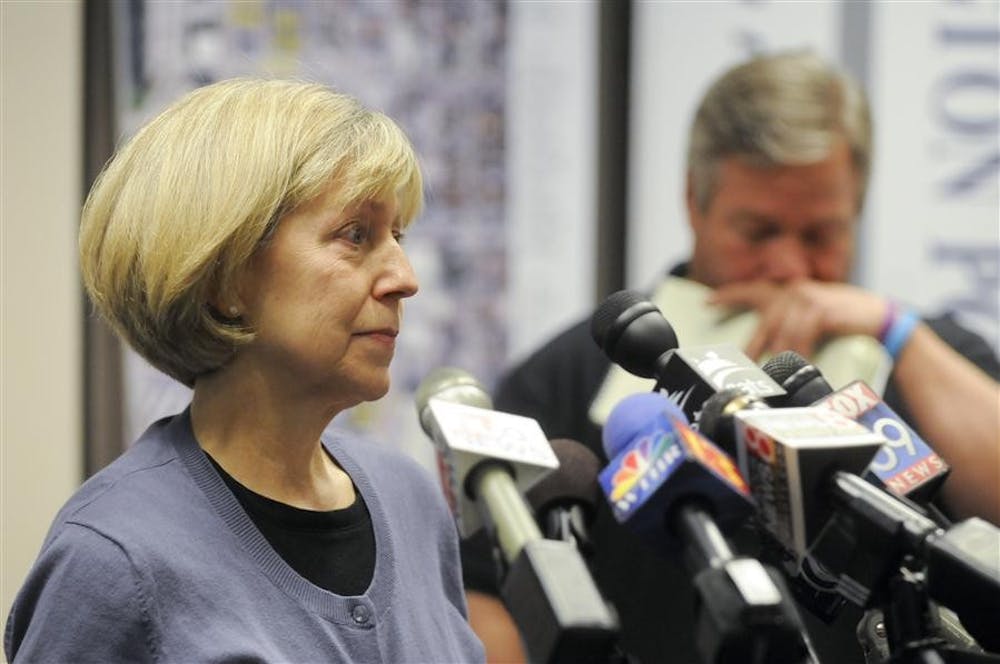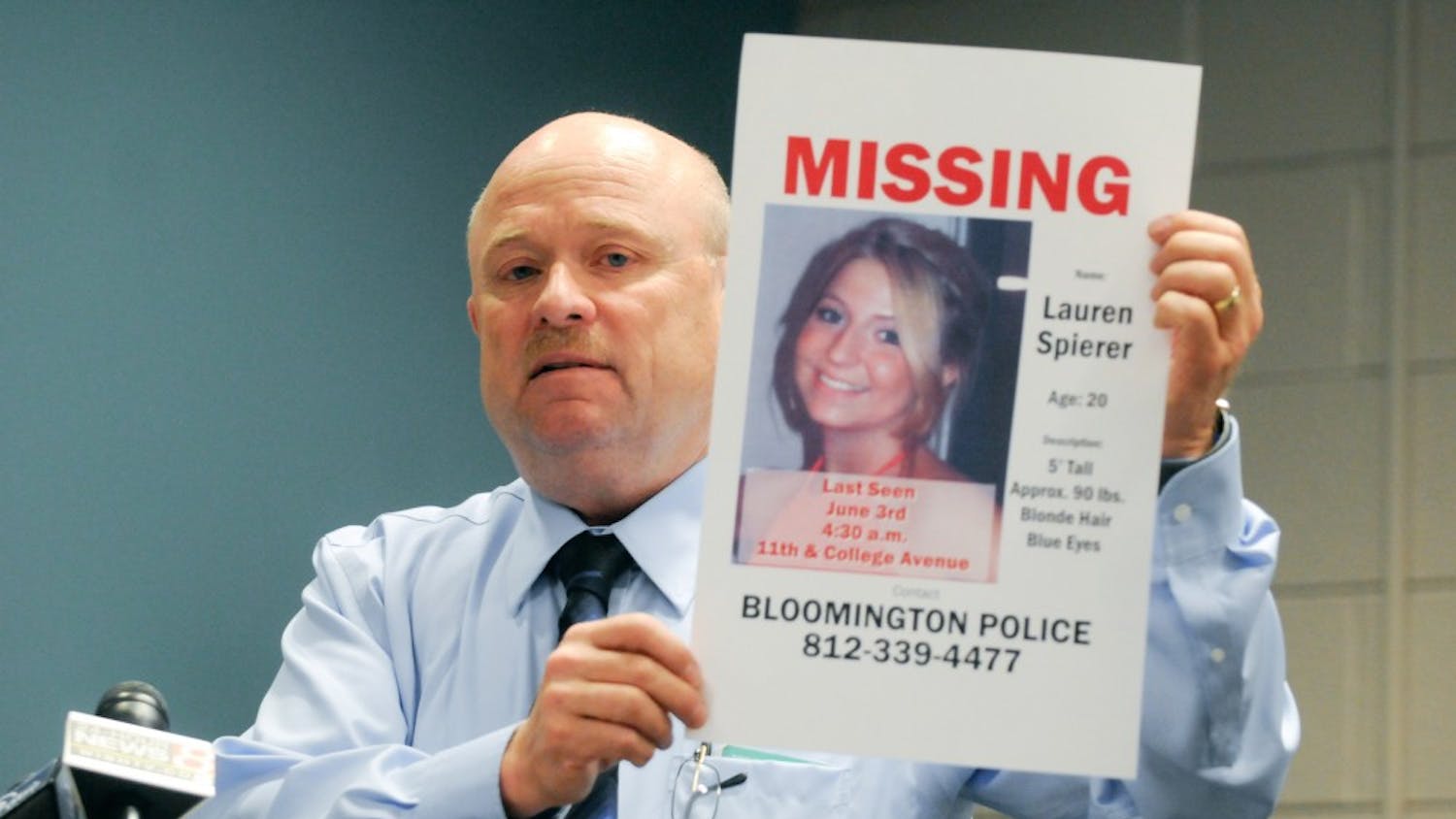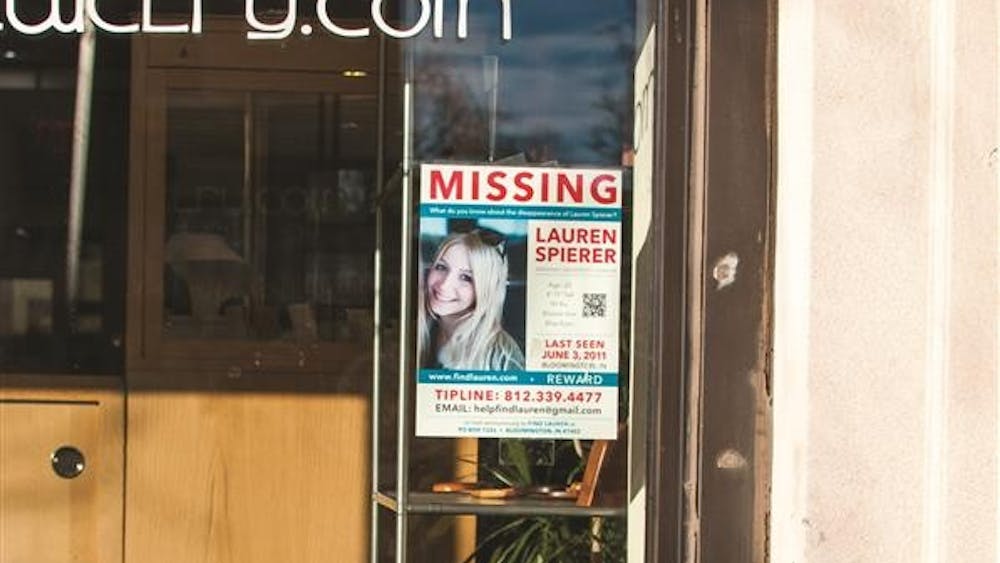Just more than a year ago, 20-year-old IU student Lauren Spierer left her apartment at Smallwood Plaza for a night out with friends. Lauren never made it back to her apartment that night and was allegedly last seen at about 4:30 a.m. June 3, 2011.
The thousands of missing person posters once hanging around town have faded, been washed away by the weather or been torn down. Evidence of what happened that night is still scarce, but the search continues. Lauren’s family and friends and the Bloomington community have banded together in hopes of bringing closure to the case and bringing Lauren home.
The following is a one-year update on where the police investigation stands, how the family and community have been affected and why Lauren is still missing.
The community
It has been one year since Lauren Spierer’s disappearance, and one year later there has been little evidence to lead investigators to the answers so many desperately seek. Walking the streets of Bloomington and the paths of IU’s campus, though, one can still find evidence of who is missing.
A few posters still hang in store windows and on lampposts around the community. The evidence of Lauren’s disappearance and the reminders that she is still gone have left a mark on the IU and Bloomington communities — a mark that will remain until Lauren is found.
“This has had an incredibly sobering impact on the community,” Bloomington Mayor Mark Kruzan said.
For many, Lauren’s disappearance was a wake-up call. Kruzan said Bloomington can feel idyllic, and this case has reminded us that, although a wonderful place to live, no place is perfect. It’s important, he said, that people remember it is still the same Bloomington and IU. Everyone just needs to be safer, he said.
“I still see examples of situations where people are taking their own safety for granted,” Kruzan said. “We have to watch out for one another.”
IU Dean of Students Harold “Pete” Goldsmith and Rabbi Sue Laikin Silberberg, executive director of the Helene G. Simon Hillel Center, emphasized the importance of a culture of care at a remembrance event Friday. Tears filled Goldsmith’s eyes and his voice broke as he addressed the crowd gathered at the Hillel Center.
“Here we are a year later, not daunted and still determined,” Goldsmith said.
Although Goldsmith praised the thousands of people who have searched for Lauren during the past year, he said there needs to be a focus on creating a community in which members take an active role in keeping each other safe. A culture where people will truly care and look out for others, he said.
“As I think about that night and how different it could have been, if only her friends would have reached out and helped her,” Laikin Silberberg said. “It hurts.”
April Cole, a Bloomington resident who has dedicated herself to the search for Lauren since the beginning, said it is evident, though, that the community really cares about finding Lauren. This search has really brought out some of the best in people, she said.
Unfortunately, as time passes, Cole said, the worst is also being brought out in people. She said she has seen so many comments by people who say hateful things and say they just want this to go away. But the community cannot disconnect itself like that, she said. It has to remember Lauren is still missing.
Kruzan, Laikin Silberberg and Cole all said the person or persons involved need to speak up about Lauren’s disappearance. Pressure from Lauren’s friends and family has been put on all of the persons of interest in the case since Lauren first went missing. But one year later, no one has come forward with the one piece of information that could lead to finding Lauren.
“I don’t know what it will take because they see the agony and the pain they are causing and they aren’t saying anything,” Laikin Silberberg said. “They are either cowards or completely uncaring and unfeeling.”
Until that day comes, Cole said, the battle to find Laruen will march on, and she doesn’t see the community backing down. No one will stop until Lauren’s family finds closure, she said.
“It’s time to put an end to this pain,” Cole said.
The investigation
Police learned of Lauren Spierer’s disappearance about 12 hours after she was last seen.
Her boyfriend, Jesse Wolff, reported her missing at 4:30 p.m. June 3, 2011. He hadn’t seen her all day, he said, and she had been out with friends the night before.
Bloomington police began canvassing the area where she was last spotted, a handful of blocks between the intersection of 11th Street and College Avenue and her apartment at Smallwood Plaza. The part of town was a maze of construction at the time — sites of what are now completed, high-priced apartment buildings. Officers talked to witnesses, checked area hospitals, viewed surveillance photos and video.
The next day, Lauren’s parents, Robert and Charlene, came to Bloomington and filed their own missing person report. Police met with them, and the Spierers began to search, too, eventually recruiting thousands of volunteers. Police remained tight-lipped to the media, the public and even the Spierers about what details they knew, if any.
On June 7, Lt. Bill Parker of the Bloomington Police Department stood in front of a crowd of reporters, cameramen and concerned — or at least curious — citizens.
Press conferences are not a common occurrence at the BPD headquarters. Media are usually dealt with through small daily meetings between a sergeant and one or two reporters. This was different.
Parker said officers and volunteers continued to look for Lauren but were limiting the search to the area for now.
“Unless we get a credible lead, we will not look in other counties,” Parker said before releasing a few details of what has now become common knowledge to the thousands searching for Lauren.
Someone had allegedly last seen Lauren at 4:30 a.m. June 3, he said. Lauren had left her cell phone and shoes at Kilroy’s Sports Bar after hanging out in the bar’s manufactured beach area. Police had recovered her purse and keys along the path between a friend’s apartment and her own. There were no suspects, but there were persons of interest.
That night, Bloomington police used battering rams to bust through the doors of Smallwood Plaza’s security and mail rooms. A crowd gathered around the building as police guarded the entrance. Inside, officers snapped photographs of both rooms before carting out three computer towers and four CD cases.
At a press conference the next day, Parker explained that police had tried to serve a search warrant to obtain the building’s security footage.
“At some point when we were trying to serve that search warrant, we were denied access,” Parker said.
Smallwood Plaza representative Chad Mertz said there simply was not an on-site staff member with a key to the rooms when police issued the warrant.
“We needed to obtain video footage,” Parker said. “We need to have it ourselves in evidence form.”
The security footage wasn’t the only evidence police were working to properly catalogue that week. Unknown to the public at the time, Bloomington police had searched the Dumpsters in the area of 11th Street and College Avenue immediately after Lauren was reported missing. Then, police determined that all Bloomington waste is sent to Sycamore Ride Landfill in Pimento, Ind., near Terre Haute.
Police had the area in the landfill designated for Bloomington waste sectioned off and secured, preventing any further waste from being dumped there. Then they began trying to work out the logistics of the search: the plan for providing food and water, how many personnel would be needed and what agencies would be involved.
And there were plenty of agencies to choose from. As the search grew and the publicity intensified, Bloomington police received help from the FBI, Team Adam of the National Center of Missing and Exploited Children, the Indiana State Police and renowned horseback search group Texas EquuSearch. The department had already worked with the Indiana University Police Department and the Monroe County Sheriff’s Office.
In addition, a private investigative firm led by former New York City Police Department detective and media personality Bo Dietl met with Bloomington Police Chief Mike Diekhoff, hoping to “partner” with the department, though Diekhoff was not receptive to the idea.
“It was evident from the discussion that at least part of their intention was to harass certain individuals,” Diekhoff said. “Obviously, that is not something that our department can sanction.”
The search continued that summer, as did the press conferences — more than a dozen of them in total. Lakes were searched. The driver of a white pickup truck seen on surveillance footage was sought but later ruled out. A segment on “America’s Most Wanted” generated 40 tips. Names of the persons of interest were published in Lauren’s hometown newspaper.
Soon, the story of Lauren’s last night out was public knowledge.
Lauren left her apartment at Smallwood Plaza and met friends at Kilroy’s Sports Bar. She briefly returned to Smallwood with another IU student, Corey Rossman. A physical altercation reportedly occurred with some of the complex’s residents, and the pair left.
Lauren and Rossman then allegedly went to Rossman’s friend’s apartment at 11th Street and Morton Avenue. Lauren reportedly decided to return to Smallwood at about 4:30 a.m. and was allegedly last seen at the intersection of 11th Street and College Avenue, just a few blocks from her apartment.
Surveillance footage of the building’s entrance shows Lauren never made it home.
As summer dragged on, the press conferences stopped and the public searches were called off. In August, police had finally figured out the logistics of the landfill search. For nine, 12-hour days, officers combed through more than 4,100 tons of trash. The hot, foul smelling search yielded no new clues.
In September, Kilroy’s Sports Bar was cited on two alcohol-related charges in relation to Lauren being served there the night of her disappearance. A report was sent by Indiana State excise police to the Alcohol and Tobacco Commission for review, and Sports could face a fine and suspension or revocation of its permit to sell alcoholic beverages.
Indiana State Police Cpl. Travis Thickstun said a decision has yet to be made.
Later that month, police heard from Bo Dietl again when, on a New York morning talk show, he referred to Chief Diekoff as “Gomer Pyle,” a dim-witted auto mechanic featured on the “Andy Griffith Show.”
“I met with the chief, and all I can say is, thank God for New York detectives,” Dietl said.
He later apologized for his remarks during a radio interview with Don Imus.
The next few months were marked by relative silence from the BPD, interrupted only by inquiries to other departments whenever a body was found in nearby areas. Ten such inquiries were made before the year anniversary, Bloomington Police Cpt. Joe Qualters said in a release Thursday. Similar inquiries have been made regarding missing person and murder cases.
By the six-month anniversary, Bloomington police had received 2,400 tips about Lauren’s disappearance, some coming from sources as far away as a psychic in California.
In the following six months, police received only 200 more tips.
Qualters said detectives have conducted hundreds of interviews, though few of these are known to be with the persons of interest. He said the department still receives “two to three credible tips” a week.
“Some place significance on the date marking one year since Lauren disappeared,” Qualters said. “But the passing of time has not deterred the effort or commitment on the part of the Bloomington Police Department to provide answers to Lauren’s family and the Bloomington community.”
The family
About 40 community members gathered at the Helene G. Simon Hillel Center on Friday to mark one year without answers about Lauren Spierer’s disappearance.
Robert and Charlene Spierer, Lauren’s parents, were unable to attend the remembrance event but sent a letter for Rabbi Sue Laikin Silberberg, executive director of Hillel, to read.
“Here we are, almost one year after Lauren’s disappearance, knowing in this very instant there are people who know where Lauren is,” the letter said. “The cruelty is almost unbearable.”
Charlene stated in the letter that they say “almost unbearable” because their family still has an undying love for Lauren. She is like a breath of fresh air, the letter continues, she is the bright spot in the day of those who know her.
On Friday morning, Robert, Charlene and Lauren’s sister, Rebecca, appeared on the TODAY Show to talk about the year they have spent without Laruen. Robert spoke about the little information the family does know. Lauren was drinking at a bar, left, stopped by her apartment and then ended up going to someone else’s apartment, Robert said. Then, for some reason, she never made it back.
“So, what we do know is that the people that were with her that night really did nothing to help her,” Robert said in the interview. “That’s, you know, part of the tragedy here is that we believe that the events would have been completely different had somebody reached out, called for help, taken her to a hospital, taken some kind of action.”
It is the thought that Lauren could have been helped by those around her that brought Robert to speak out to help this from happening to more families in the future.
It is clear that in this country, underage drinking is rampant, he said, and things could change if other states follow Indiana’s lead and pass a Lifeline Law, which allows people in illegal consumption cases to call the police to help someone and not be subject to prosecution.
During the interview, Charlene had to face one of the hardest questions the parent of a missing child has to answer — Do you have hope that she could be found alive?
“You know, you always have hope,” Charlene said. “But after a year I don’t think it’s likely.”
To get their answers, though, Charlene said it will most likely take the people who were with Laruen to speak up. She said the lines of communication became either nonexistent or severely limited soon after the investigation began, and to this day, most of the people they need to talk to have not taken police polygraphs, which is what the Spierer family has been asking for from the beginning, she said.
In the Spierers’ letter to those attending the remembrance event in Bloomington, the family thanked everyone for their continued support and search efforts. In the end, the letter summed up what is continuing to drive the Spierers in their search.
“Lauren would never give up, she would fight for answers, she would be the loudest voice,” the Spierers’ letter read. “We will never give up, we will fight for answers, and we will be her voice.”






